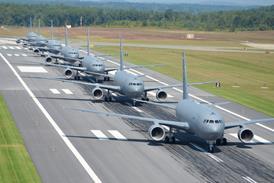The impact of reduced output will be felt in manufacturing for the next two years but the overall health of the industry is improving
Investors are wise to be wary of the aviation and aerospace industries. As the commercial air transport sector begins its now-traditional slide into red ink on the down slope of the latest economic cycle, it is logical to expect the manufacturing sector to follow suit. And the signs are already clear. Airbus and Boeing have scaled back their delivery forecasts for the next couple of years and even Embraer, riding high on the popularity of regional jets, has revised its forecast downwards as airlines shy away from converting options to firm orders.
Flight International's Aerospace Top 100, produced in association with strategy consultants Roland Berger, is an annual report on the worldwide manufacturing industry's financial performance. This year's survey shows that signs of the latest downturn were visible in 2000. Overall revenue growth for the Top 100 companies slowed to just 1% last year, down from 5% in 1999, 12% in 1998 and 17% in 1997.
But how does that gel with the fact that aerospace companies, led by Boeing and EADS, have reported strong revenue and earnings growth for the first half of this year? And will the tightening grip of the airline recession reverse those gains and result in a fall in overall Top 100 revenues for the full year?
This year's Top 100, based on 2000 financial results, shows an industry in transition. European giant EADS enters the table for the first time, at number three, following the July 2000 merger of Aerospatiale Matra, Daimler Chrysler Aerospace and Casa. The company would have rivalled Lockheed Martin for the number two position had it not been for the strong dollar and the weak Euro. It is a situation EADS intends to remedy this year, with a projected 20% increase in revenues certain to vault the company into second place behind Boeing if it is achieved. EADS' improvement this year is primarily due to higher Airbus deliveries, set to reach 330 aircraft by year-end. But Boeing has been no slouch and after last year's substantial slide on deliveries (to 489 aircraft from 620 in 1999 - the $7.3 billion drop in revenues at Boeing Commercial Airplanes equated to no less than 2.5% of the total Top 100 turnover in 2000), the company has recovered strongly and has actually revised its delivery plans for this year upwards, to 538 aircraft.
The next two years could be different. Airbus expects to deliver 400 aircraft next year but now plans to hold production at that level for 2003, instead of increasing to 450 aircraft. Boeing still expects to deliver 510 to 520 commercial aircraft next year, but expects this to slip to 490 to 510 in 2003. Both companies may struggle to reach the 400-aircraft order intake level they have each projected for this year as airlines decline to exercise the options they hold.
The impact of reduced output will be felt throughout the Top 100 for the next two years at least, but will it be as damaging as the low points of previous economic cycles? This year's survey makes one thing clear: the overall health of the manufacturing industry is improving. While revenues remained generally static, profitability on a dollar basis increased by 12%, on top of the 10% improvement in 1999. The reason? The widespread cost-cutting and leaning out of the industry that has gathered pace over the past few years.
That the US leads in profitability shows the crushing wave of consolidation that has reshaped its industry is starting to pay dividends. Further evidence has emerged in the first half of this year, with the major US aerospace companies all posting improved results. Profits are up and huge levels of cashflow are lightening the massive debt load the consolidation leaders accumulated during their acquisition binges. The universal focus on running healthy businesses is paying off. Funny it should be such a new idea for the aerospace industry.
Now comes the test. Can the manufacturing industry survive the ritual self-destruction of the airlines? Perhaps, this time around. Defence business is on the rebound and the US Department of Defense's decision to approve the F-22 fighter for production is a welcome relief to manufacturers Lockheed Martin and Boeing. The on-schedule selection of a winner of the Joint Strike Fighter competition will be a huge boost for one or the other of the two companies, but is likely to benefit both as well as the whole supply chain. The Bush Administration's focus on missile defence means a potentially massive business opportunity - and not just for US companies.
This may just be the economic cycle where the airlines' periodic blood-letting does not lead the manufacturing industry lemming-like over the profitability precipice. But it will require focus from managers and faith from investors.
Source: Flight International























